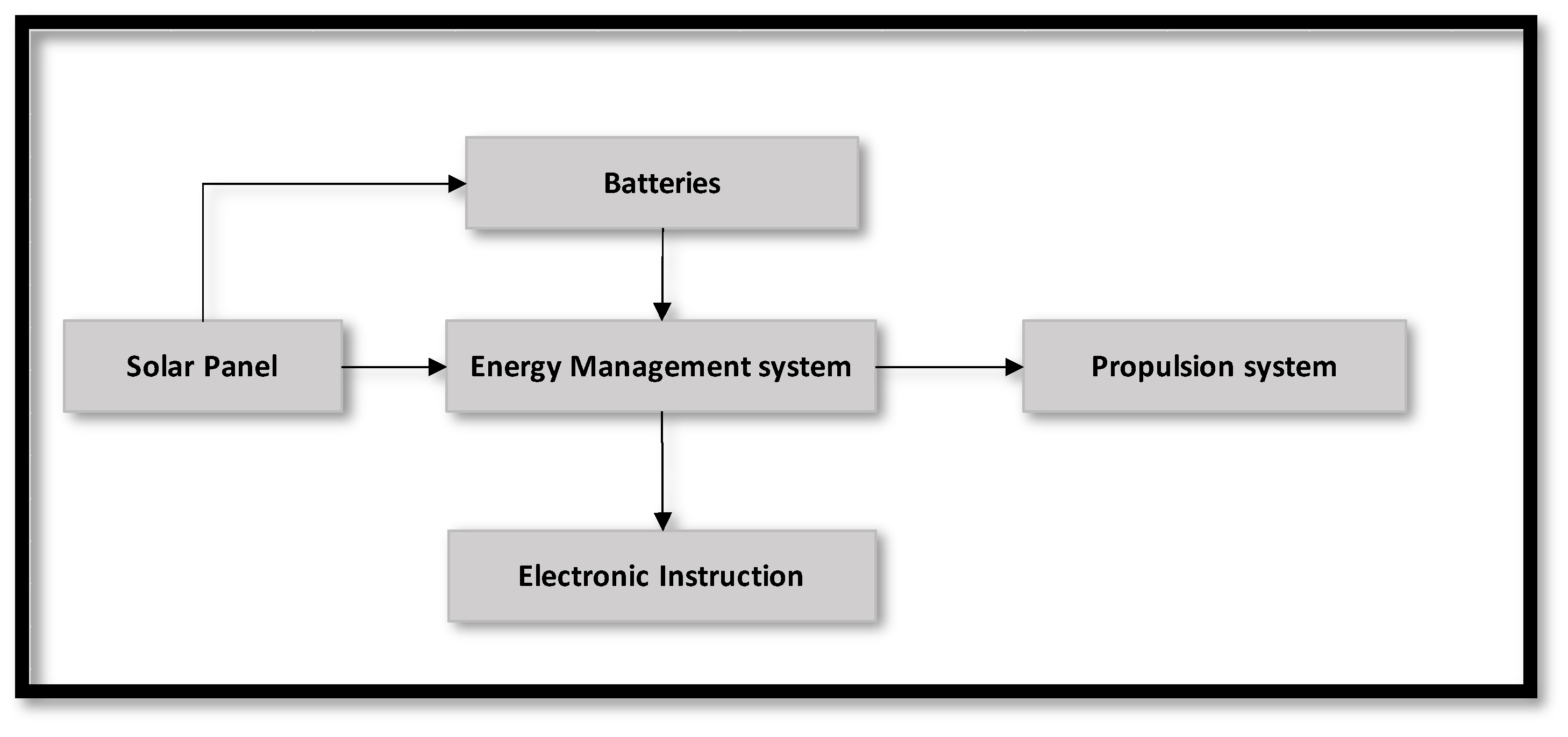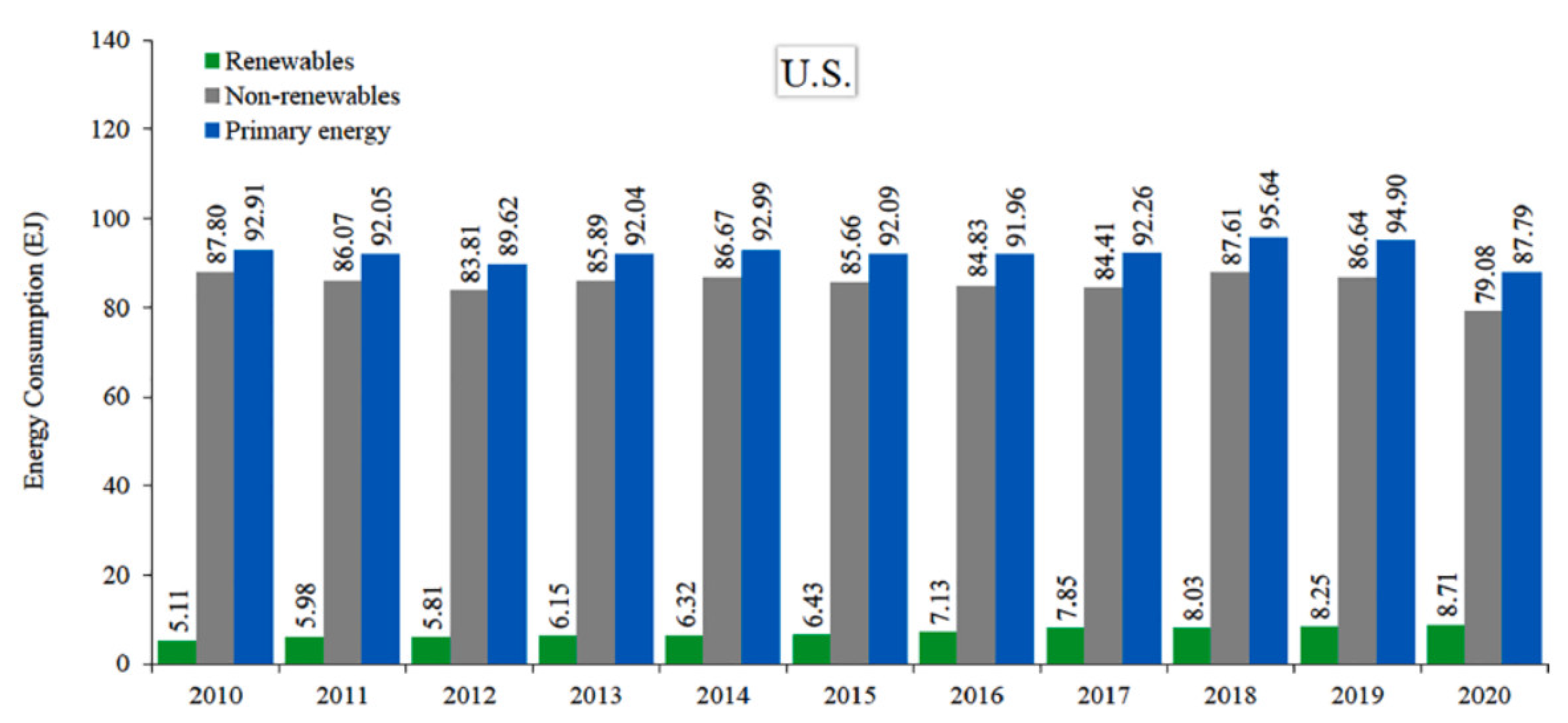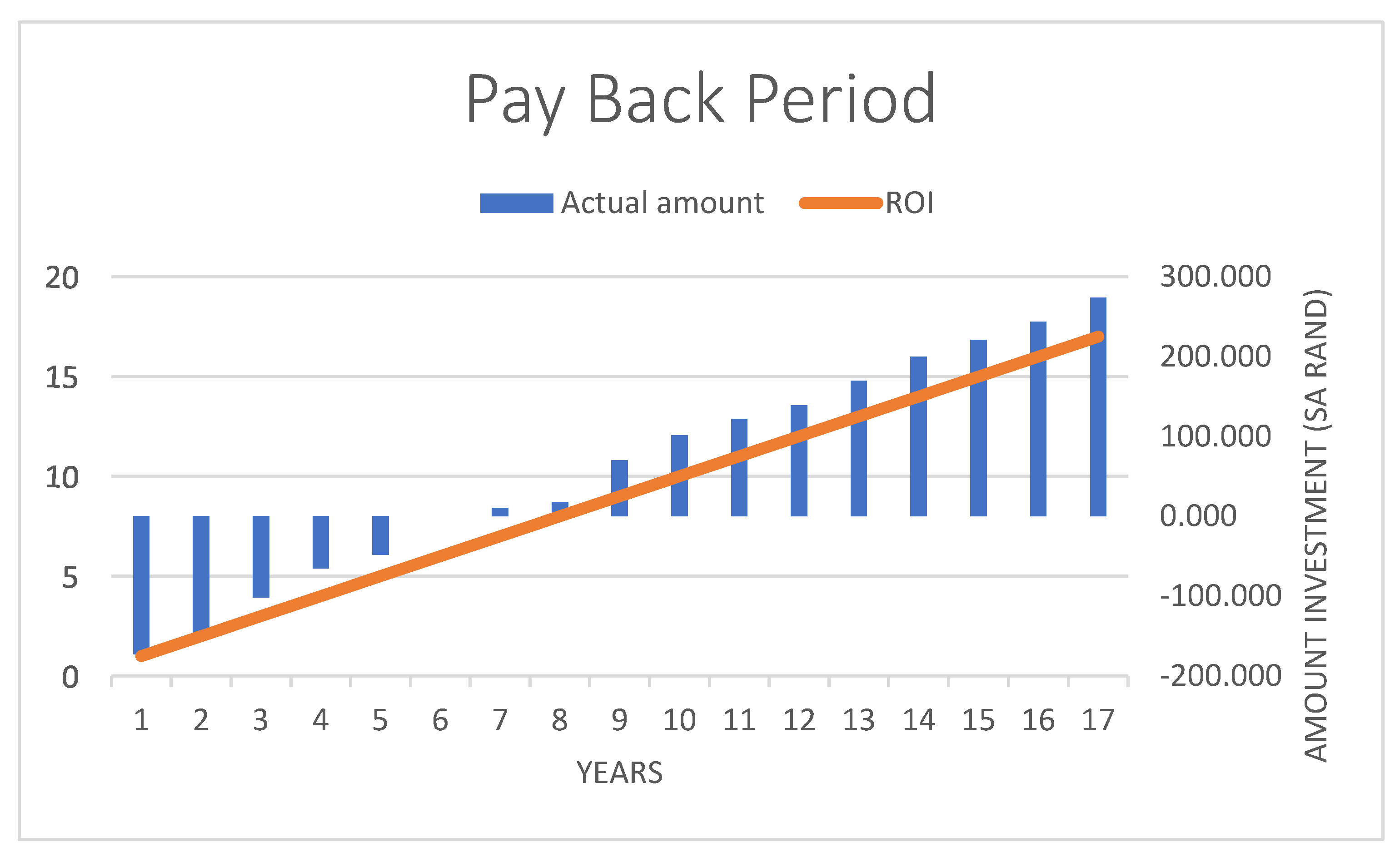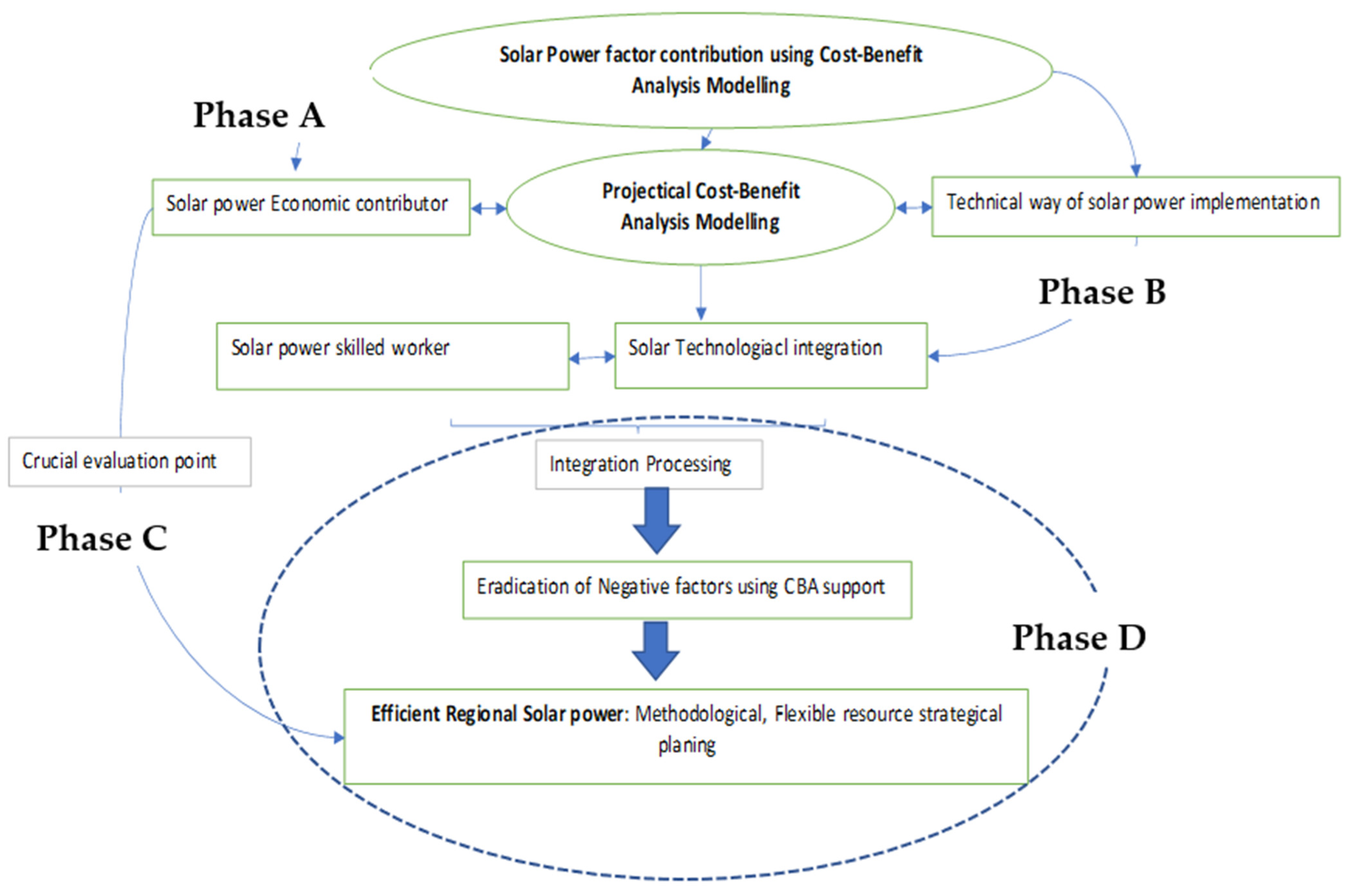Eradication of Solar Power Unsustainability through Cost-Benefit Analysis: KwaZulu Natal Case Study
Abstract
1. Introduction
- -
- Why is solar power believed to be highly unimplementable in the coastal regions such as KZN?
- -
- What financial stakeholders are reluctant to support solar power energy in coastal regions?
- -
- Will the implementation of solar power energy be sustainable for the next decade?
2. Literature Review
2.1. Sustainability Overview
2.2. Financial Factors Affecting Renewable Energy
2.3. Technological and Environmental Overview
2.4. Energy Consumption Overview
3. Materials and Methods
3.1. Research Design and Gathering Approach
3.2. Sample and Population
3.3. Cost-Benefit Model
- Σ—summation sign
- TB—total benefits,
- T—represents the sum of all the tangible benefits of solar energy activities carried out in the KZN region [7].
- I—represents all the activities that belong under the intangible category. Adding up all the activities with both tangible and intangible benefits give the required total benefits [4].
- n is for all activities.
- m is for all activities.
- Ii—initial investment
- TB—total benefits
- TC—total costs
- Toi—Taxable operating income
- Tp—Tax payable
- EBIT—earning before income tax
- OIT—operating income tax.
4. Results and Discussion
Financial Analysis and Projection of Cost-Benefit Analysis
- FTC—feed-in tariff cost,
- FTR—feed-in tariff rate,
- FTCh—feed-in tariff charge.
- CT—customer tariff,
- SE—self-use energy
- ST—self-use tariff
5. Recommendations
5.1. Economical, Methodological and Environmental (EME) Framework Analysis of Measured Solar Challenges
5.2. Economic Breakdown of Solar Power in the Region of KZN
5.3. Methodological Breakdown of Solar Power in the Region of KZN
- Solar power research and development—this aspect can benefit the region since there will be a better understanding of the technology required in the KZN region. It will prepare the solar power system organizers for future technology and increase the opportunity to develop relevant technology for the region rather than benchmarking against developed countries, e.g., Germany [7]. There is nothing wrong with benchmarking, but it must be remembered that other countries use technology that suits their solar radiance and temperature. This creates an opportunity for solar power products with superior performance to be manufactured once the relevant parameters have been analysed [7].
- Solar power training and financing policy—this will assist in reducing implementation time and the waste of solar power material, provided training is maximized through proper training policies to ensure proper skills transfer for renewable energy as a whole at the regional level [7]. This process will need to be guided by policies directed towards renewable energy such as solar power [7]. For example, a solar power financing policy should be developed since the author was unable to access such a policy for the KZN region during his research for this study. Both SP research and development as well as SP training and financing policy could help reduce the premature collapse of the SP system [7].
5.4. Incapacitating Solar Power Unsustainability in the KZN Region
6. Conclusions
Author Contributions
Funding
Data Availability Statement
Conflicts of Interest
References
- Obaideen, K.; AlMallahi, M.N.; Alami, A.H.; Ramadan, M.; Abdelkareem, M.A.; Shehata, N.; Olabi, A.G. On the contribution of solar energy to sustainable developments goals: Case study on Mohammed bin Rashid Al Maktoum Solar Park. Int. J. Thermofluids 2021, 12, 100–123. [Google Scholar] [CrossRef]
- Afonso, A.; Tovar, J. Soveriegn debt composition and time varying public finance sustainability. N. Am. J. Econ. Financ. 2017, 42, 144–155. [Google Scholar] [CrossRef]
- Currie, P.K.; Musango, J.K.; May, N.D. Urban metabolism: A review with reference to Cape Town. Cities 2017, 70, 91–110. [Google Scholar] [CrossRef]
- Şahin, U. Forecasting share of renewables in primary energy consumption and CO2 emissions of China and the United States under COVID−19 pandemic using a novel fractional nonlinear grey model. Expert Syst. Appl. 2022, 209, 118429. [Google Scholar] [CrossRef]
- Mark, L.; Legget, W.; Ball, A. The implication for climate change and peak fossil fuel of the continuation of the current trend in wind and solar energy production. Energy Policies 2022, 41, 610–617. [Google Scholar]
- Depren, S.K.; Kartal, M.T.; Çelikdemir, N.; Depren, Ö. Energy consumption and environmental degradation nexus: A systematic review and meta-analysis of fossil fuel and renewable energy consumption. Ecol. Inform. 2022, 70, 101747. [Google Scholar] [CrossRef]
- Mdlolo, B. Investigating the Root Cause OF Solar Power Unsustainability in Kwazulu-Natal, South AFRICA; Durban University of Technology: Durban, South Africa, 2019. [Google Scholar]
- Sakah, M.; Diawuo, F.A.; Katzenbach, R.; Gyamfi, S. Towards a sustainable electrification in Ghana: A review of renewable energy deployment policies. Renew. Sustain. Energy Rev. 2017, 79, 544–557. [Google Scholar] [CrossRef]
- Pan, C.A.; Dinter, F. Combination of PV and central receiver CSP plants for base load power generation in South Africa. Sol. Energy 2017, 146, 379–388. [Google Scholar] [CrossRef]
- Van Ravenswaay, J.; Roos, T.; Surridge-Talbot, A.; Xosa, S.; Sattler, C. Development of a Solar Fuels Roadmap for South Africa. Energy Procedia 2015, 69, 1838–1848. [Google Scholar] [CrossRef]
- Nuortimo, K.; Härkönen, J.; Karvonen, E. Exploring the global media image of solar power. Renew. Sustain. Energy Rev. 2018, 81, 2806–2811. [Google Scholar] [CrossRef]
- Zawilska, E.B.M. An assessment of the solar resource for Durban, South Africa. Renew. Energy 2011, 36, 3433–3438. [Google Scholar] [CrossRef]
- Hachicha, R.I.G.C. Thermo-hydraulic analysis and numerical simulation of a parabolic trough solar collector for direct steam generation. Appl. Energy 2018, 214, 152–165. [Google Scholar] [CrossRef]
- Bohlmann, J.; Inglesi-Lotz, R. Analysing the South African residential sector’s energy profile. Renew. Sustain. Energy Rev. 2018, 96, 240–252. [Google Scholar] [CrossRef]
- Mälkki, H.; Alanne, K.; Hirsto, L. A method to quantify the integration of renewable energy and sustainability in energy degree programmes: A Finnish case study. J. Clean. Prod. 2015, 106, 239–246. [Google Scholar] [CrossRef]
- Dostál, Z.; Ladányi, L. Demands on energy storage for renewable power sources. J. Energy Storage 2018, 18, 250–255. [Google Scholar] [CrossRef]
- Frondel, M.; Schmidt, C.M.; Vance, C. Revisiting Germany’s solar cell promotion: An unfolding disaster. Econ. Anal. Policy 2014, 44, 3–13. [Google Scholar] [CrossRef]
- Weida, S.; Kumar, S.; Madlener, R. Financial Viability of Grid-connected Solar PV and Wind Power Systems in Germany. Energy Procedia 2016, 106, 35–45. [Google Scholar] [CrossRef]
- Spachos, P.; Mackey, A. Energy efficiency and accuracy of solar powered BLE beacons. Comput. Commun. 2018, 119, 94–100. [Google Scholar] [CrossRef]
- Dinh, D.K.; Lee, D.H.; Song, Y.-H.; Jo, S.; Kim, K.-T. Arc length control for efficiency enhancement of energy usage in plasma dry reforming process. J. CO2 Util. 2018, 28, 274–282. [Google Scholar] [CrossRef]
- Schwerhoff, G.; Sy, M. Financing renewable energy in Africa—Key challenge of the sustainable development goals. Renew. Sustain. Energy Rev. 2017, 75, 393–401. [Google Scholar] [CrossRef]
- Jadhav, A.S.; Chembe, D.K.; Strauss, J.M.; Van Niekerk, J.L. Status of Solar Technology Implementation in the Southern African Developing Community (SADC) Region. Renew. Sustain. Energy Rev. 2017, 73, 622–631. [Google Scholar] [CrossRef]
- Polzin, F.; Sanders, M.; Täube, F. A diverse and resilient financial system for investments in the energy transition. Curr. Opin. Environ. Sustain. 2017, 28, 24–32. [Google Scholar] [CrossRef]
- Gxasheka, H. Mokhonoana and R. Mokoena. Monitor of Renewable Energy Performance of Power Plants–Progress in the First Half of 2018—Issue 12; NERSA: Pretoria, South Africa, 2018. [Google Scholar]
- Aliyu, A.K.; Modu, B.; Tan, C.W. A review of renewable energy development in Africa: A focus in South Africa, Egypt and Nigeria. Renew. Sustain. Energy Rev. 2018, 81, 2502–2518. [Google Scholar] [CrossRef]
- Chen, X.; Li, X.; Zhu, H. Condition evaluation of urban metro shield tunnels in Shanghai through multiple indicators multiple causes model combined with multiple regression method. Tunn. Undergr. Space Technol. 2018, 85, 170–181. [Google Scholar] [CrossRef]
- Marzo, M.; Alía, R.G.; Infantino, A.; Brucoli, M.; Danzeca, S. Fuentealba. Impact of neutrons on the Rad FET dose response when exposed to mixed fields. Radiat. Phys. Chem. 2018, 127, 871–882. [Google Scholar]
- Jain, S.; Jain, P. The rise of Renewable Energy implementation in South Africa, in World Engineers Summit—Applied Energy Symposium & Forum: Low Carbon Cities & Urban Energy Joint Conference. Energy Procedia Singap. 2017, 143, 721–724. [Google Scholar]
- Damari, Y.; Kissinger, M. An integrated analysis of households’ electricity consumption in Israel. Energy Policy 2018, 119, 51–58. [Google Scholar] [CrossRef]
- Destek, M.A.; Manga, M.; Cengiz, O.; Destek, G. Investigating the potential of renewable energy in establishing global peace: Fresh evidence from top energy consumer countries. Renew. Energy 2022, 197, 170–177. [Google Scholar] [CrossRef]
- NERSA. Monitoring_Renewable_Performance_of_Power_Plants, in Tracking Progress of 2017; NERSA: Pretoria, South Africa, 2017. [Google Scholar]
- Yang, T.; Segets, D.; Thajudeen, T.; Han, Y.; Peukert, W. The effect of mixing on silver particle morphology in flow synthesis. Chem. Eng. Sci. 2018, 192, 254–263. [Google Scholar] [CrossRef]
- Ntshalintshali, S. By 2030 eThekwini Will Be Africa’s Most Caring and Loveable City, in eThekwini Magazine, eThekwini Municipality; eThekwini Municipality: Durban, South Africa, 2016. [Google Scholar]
- Ozorhon, B.; Batmaz, A.; Caglayan, S. Generating a framework to facilitate decision making in renewable energy investments. Renew. Sustain. Energy Rev. 2018, 95, 217–226. [Google Scholar] [CrossRef]
- Ghenai, K.; Alamara, K.; Inayat, A. Solar Assisted Pyrolysis of Plastic Waste: Pyrolysis Oil Characterization and Grid-Tied Solar PV Power System Design. Energy Procedia 2019, 159, 123–129. [Google Scholar] [CrossRef]




| Communication Types | Description of Uses |
|---|---|
| Emailing | -Initially used to schedule meetings between the researcher and municipal representatives. -To receive data and send follow-up questions from the researcher to the municipal representatives. |
| Telephoning | -Used to remind the municipal representatives about meetings and to follow up of how far the person with expected data is. |
| Face-to-face meetings | -Used to introduce the researcher and to outline the type of data expected from each partner. |
| 1. Output | Unit |
|---|---|
| Total capacity | 10 kWp |
| Annual insolation | 1890 kWh/m2 |
| Performance ratio | 83.0% |
| Annual degradation | 0.30% |
| Yearly production (first year) | 15,687 kWh |
| Per cent self-use | 95% |
| 2. Income and rates | |
| Customer tariff (avoided electricity) | 1.35 R/kWh |
| Feed-in tariff | 0.65 R/kWh |
| Carbon credit | 0 R/kWh |
| Tax rate | 28% |
| Inflation adjustment | 7% per annum |
| 3. Investment and installation | |
| Turnkey EPC | 18,000 R/kWp |
| Grid connection | R0 |
| Project development | R1000 |
| Other initial costs | R0 |
| Decommission | 0 R/kWp |
| 4. Expenses | |
| Upkeep (first year) | 400 R/kWp/annum |
| Allowance for component change (first year) | 1000 R/annum |
| Land/Roof Lease | 0 R/annum |
| Insurance premium | 0.8% of initial invest |
| Cost Benefit Analysis (CBA) | ||||||||||||||||||
|---|---|---|---|---|---|---|---|---|---|---|---|---|---|---|---|---|---|---|
| Total Benefit (TB) | Year | |||||||||||||||||
| Unit | 1 | 2 | 3 | 4 | 5 | 6 | 7 | 8 | 9 | 10 | 11 | 12 | 13 | 14 | 15 | 16 | 17 | |
| Total Tangible Benefit | ||||||||||||||||||
| Energy produced | kWh | 15,687 | 15,640 | 15,593 | 15,546 | 15,499 | 15,452 | 15,405 | 15,358 | 15,311 | 15,263 | 15,216 | 15,169 15,122 | 15,075 | 15,028 | 14,981 | 14,934 | |
| Self-use | kWh | 14,903.00 | 14,858 | 14,813 | 14,769 | 1472 | 14,679 | 14,634 | 14,590 | 14,545 | 14,500 | 14,456 | 14,411 14,366 | 14,321 | 14,277 | 14,232 | 14,187 | |
| Feed in tariff | kWh | 784 | 782 | 780 | 777 | 775 | 773 | 770 | 768 | 766 | 763 | 761 | 758 | 756 | 754 | 751 | 749 | 747 |
| Feed in tariff | R/kWh | 1 | 1 | 1 | 1 | 1 | 1 | 1 | 1 | 1 | 1 | 1 | 1 1 | 1 | 1 | 1 | 1 | |
| Customer r tariff | R/kWh | 2 | 2 | 2 | 2 | 2 | 2 | 2 | 2 | 2 | 2 | 2 | 2 2 | 2 | 2 | 2 | 2 | |
| Carbon credit | R/kWh | 0 | 0 | 0 | 0 | 0 | 0 | 0 | 0 | 0 | 0 | 0 | 0 | 0 | 0 | 0 | 0 | 0 |
| Total TB cost | R/kWh | 30,590 | 30,498 | 30,406 | 30,314 | 30,223 | 30,131 | 30,039 | 29,947 | 29,855 | 29,764 | 29,672 | 2958 | 29,488 | 29,397 | 29,305 | 29,213 | 29,121 |
| b) Intangible Benefit | ||||||||||||||||||
| Rent cost | R/kWh | 300 300 | 3000 | 3000 | 4500 | 4500 | 4500 | 4500 | 4500 | 4500 | 5000 | 500 | 500 | 5500 | 5500 | 5500 | 5800 | |
| Grid connection licence | R | 1100 | 1100 | 1100 | 1100 | 1100 | 1100 | 1100 | 1100 | 1200 | 1200 | 1200 | 1200 | 1200 | 1200 | 1200 | 1200 | 1200 |
| Total benefit | R | 34,690 | 34,598 | 34,506 | 34,414 | 35,823 | 35,731 | 35,639 | 35,547 | 35,555 | 35,464 | 35,872 | 3578 | 35,688 | 36,097 | 36,005 | 35,913 | 36,121 |
| Total CT (expenses) | ||||||||||||||||||
| a) Developmental cost | ||||||||||||||||||
| Project development | R | 50,000 | ||||||||||||||||
| Labour cost | R | −44,000 | ||||||||||||||||
| Transportation cost | R | 45,000 | ||||||||||||||||
| Solar panel cost | R/m′ | 25,000 | ||||||||||||||||
| b) Operational Cost | ||||||||||||||||||
| Facilities management | R/kWh | −1000 | −1070 | −1145 | −1225 | −1311 | 1403 | 1501 | 1606 | −1718 | −1838 | 1967 | −2105 | −2252 | −2410 | −2579 | −2759 | −2952 |
| Depreciation | R | 36,200 | 0 | 0 | 1 | 0 | 0 | 0 | 0 | 0 | 0 0 0 | 0 | 0 | |||||
| Allowance of component change | R | 1000 | 10,700 | 1145 | 1225 | 1311 | 1403 | 1501 | 1606 | 1718 | −1831 | 1967 | −2105 | −2252 | −2410 | −2479 | 2759 | 2952 |
| Maintenance cost | R/kWh | −4000 | 4280 | 4580 | 4900 | 5243 | 5610 | −6003.00 | 6423 | 6873 | 7354 | 7869 | 8419 | 9009 | 9639 | 10,314 | 11,036 | 11,809 |
| Insurance premium | R | 1448 | −1448 | 1441 | 1448 | 1448 | 1448 | 1441 | −1448 | −1448 | 1441 | 1441 | 1448 | −1448 | −1441 | −1441 | 1448 | 1448 |
| Total cost | R | 207,641 | 7868 | −8317 | −8798 | 9313 | 9863 | 10,452 | 11,083 | −11,157 | −12,479 | 13,251 | 14,077 | 16,919 | −15,907 | −16,919 | 11,002 | 19,161 |
| EBIT | R | 8042 | 2673 | 26,189 | 25,610 | 25,610 | 25,867 | 25,137 | 24,465 | 23,798 | 22,985 | 22,621 | 21,703 20,727 | 20,100 19,086 | 17,911 16,960 | |||
| Taxable operating income | R | −172,958 | 2673 | 26,189 | 2561 | 2651 | 25,867 | 25,137 | 24,465 | 23,798 | 22,985 | 22,621 | 21,703 | 20,727 | 20,100 | 19,086 | 17,911 | 16,960 |
| Operating income tax | R | 0 | 7484 | 7333 | 7173 | 26,189 | 7423 | 7243 | 7052 | 6850 | 6660 | 6436 | 6334 | 6077 | 580 | 5653 | 5344 | 5015 |
| Operating income After Tax | R | −172,958 | 3421 | 33,522 | 32,789 | 33,933 | 3311 | 32,239 | 31,315 | 30,462 | 29,421 | 28,955 | 2778 | 26,531 | 25,843 | 244,301 | 22,926 | 21,709 |
| Return On Investment (ROI) | R | −172,958 | −138,744 | −10,522 | −72,434 | −38,501 | −5391 | 26,848 | 58,163 | 88,624 | 118,045 | 147,000 | 174,780 | 201,311 | 227,154 | 251,583 | 274,509 | 296,219 |
Publisher’s Note: MDPI stays neutral with regard to jurisdictional claims in published maps and institutional affiliations. |
© 2022 by the authors. Licensee MDPI, Basel, Switzerland. This article is an open access article distributed under the terms and conditions of the Creative Commons Attribution (CC BY) license (https://creativecommons.org/licenses/by/4.0/).
Share and Cite
Mdlolo, B.N.; Olanrewaju, O.A. Eradication of Solar Power Unsustainability through Cost-Benefit Analysis: KwaZulu Natal Case Study. Energies 2022, 15, 7554. https://doi.org/10.3390/en15207554
Mdlolo BN, Olanrewaju OA. Eradication of Solar Power Unsustainability through Cost-Benefit Analysis: KwaZulu Natal Case Study. Energies. 2022; 15(20):7554. https://doi.org/10.3390/en15207554
Chicago/Turabian StyleMdlolo, Bantubenzani Nelson, and Oludolapo Akanni Olanrewaju. 2022. "Eradication of Solar Power Unsustainability through Cost-Benefit Analysis: KwaZulu Natal Case Study" Energies 15, no. 20: 7554. https://doi.org/10.3390/en15207554
APA StyleMdlolo, B. N., & Olanrewaju, O. A. (2022). Eradication of Solar Power Unsustainability through Cost-Benefit Analysis: KwaZulu Natal Case Study. Energies, 15(20), 7554. https://doi.org/10.3390/en15207554







